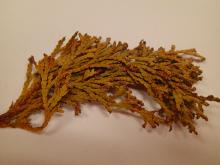Includes Argyresthia cupressella and others
Pest description and damage There are nine different Argyresthia species that attack different conifers (pine, hemlock, etc.) in the Pacific Northwest. The cypress tip moth (or cypress tip miner) is common enough to merit attention in many books. The moth is a mottled silver-tan with an approximately 0.3-inch wingspan. Mature larvae are green, about 0.13 inch in length. Larvae mine in the growing points of the 1- and 2-year-old shoot tips. The cocoon is white and visible as a papery structure in the axils of leaf scales. Damage typically is limited to the tips of twigs. The exit holes are dark and may resemble symptoms of leaf blight, a fungal disease. Affected foliage does not discolor until late winter. After this, the brown dead twigs break off readily. Cultivars of Juniperus chinensis, J. virginiana, and J. sabina also are affected. The entire plant can appear brown in a severe infestation, and repeated infestations cause dieback. Failure to gain control may require taxonomic identification to ensure the Argyresthia species.
For biology, life history, monitoring and management
See:
Juniper (Juniperus)-Cypress tip moth
Management-chemical control
See Table 3 in:


